Nobody's Fault But Mine
 |
We don't know who wrote Nobody's Fault But Mine because no one person did. It first arose and took its basic form in the black Pentacostal church, where it would have been reckoned a gift of the Holy Spirit by a congregation well-primed to receive the blessing. In that context the "song" provides a structure or template—what improvisers in theater or dance might call a "score"—within which the song leader and congregation craft a newly-inspired work with every iteration, like this one from the mid-1930's:
Audio Clip: the Milledgeville Georgia Singers,1934 (Ain't) Nobody's Fault But Mine
It is in the very nature of such songs, then, that they are open to infinite reinterpretation within the broad confines of the score they provide. And whatever your personal beliefs regarding inspiration's ultimate source—Holy Spirit, native genius, or what have you—our brief tour here will make clear that it never seems to tire of reworking the clay of this particular song, again and again molding a new thing of enduring beauty.
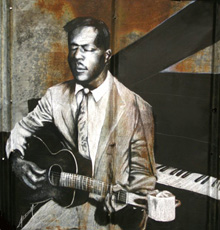 |
The earliest known recording of the song is a brilliant guitar and vocal interpretation by Blind Willie Johnson dating back to 1927. The gruff-voiced Texan had a short recording career (30 songs in 3 years) but many of those are considered classics of the gospel-blues genre, at least among guitarists. Though a solo performance, the call-and-response between Johnson's voice and guitar echos the song's congregational roots, as does the spontanaiety with which it is offered—here's a guy who's listening for the the commands of the Spirit even as he sings its praises. His guitar is in open D tuning and he's playing slide with a pocket knife. Notice that in his version the chord ( D major) never really changes.
Audio Clip: Blind Willie Johnson, 1927, It's Nobody's Fault But Mine
 |
Like many other talented artists with musical roots in the black church, Sister Rosetta Tharpe struggled to remain in the good graces of her gospel base while attempting to cross over to a wider secular audience. Even in this thoroughly gospel-oriented cut you can hear that she very clearly had the "stuff" to move whenever and wherever the spirit said move. And not only as a strong and nuanced singer—that's her on guitar, on which she excelled from a very young age. She's playing the song using standard blues changes in A major, but the attentive guitar-geek will note that about 3 seconds into this clip you hear a really low A (one full octave below the 5th string!) I have seen it suggested that Tharpe played in a so-called "vestapol" tuning—just another name for open D—but that only gets your 6th string down one whole step to D, with another two and a half steps to go. My guitar would sound like it was strung with silly putty if I attempted this. Must be divine intervention. Listen to this cut and you'll see why "the original soul sister" had God on her side.
Audio Clip: Sister Rosetta Tharpe, 1941, Nobody's Fault But Mine
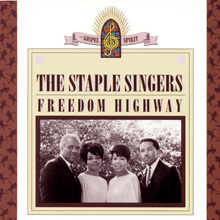 |
Roebuck "Pops" Staples could have performed the song in a similar solo acoustic guitar & vocal style had he chosen. But having gone forth and multiplied in the early 1930's he found himself blessed with a talented brood by the latter part of the next decade and opted for performing with them as The Staple Singers. They eventually crossed over as a mainstream act with a dozen charting hits during their years at Stax alone (I'll Take You There). But they recorded Nobody's Fault at an earlier point in their career, mid-60's, at the crossroads where black folks met white and where gospel met the charged social-justice movements of the day. The Staple Singers parked themselves squarely there for some time, contributing with equal passion to movements inner and outer. Here's a bit of that, with Pops on lead vocals and playing what Rob Bowans (in the linked bio) calls "heavily reverbed Mississippi cotton-patch guitar."
Audio Clip: The Staple Singers perform Nobody's Fault But Mine
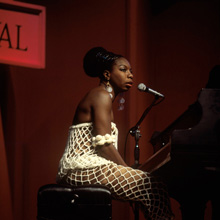 |
There are many other fine renditions of this song we might include that, for all their distinctiveness, more or less stay between the lines we've laid down so far, including those of Mance Lipscomb, The Five Blind Boys of Alabama, Eric Bib, David Bromberg, and countless gospel groups. Even Tom Jones and Willie Nelson have covered it. Check them out, by all means. I'm only skipping them here because, as noted at the top, this song has inspired such a variety of readings. From here on out I'll focus on those that clearly move us into new musical territory. Which you can always count on Nina Simone to do—not only from one era of her career to another, but from one song to the next on the same album. Don't bother trying to classify her. Just listen.
Audio Clip: Nobody's Fault But Mine, from her Nina Simone and Piano!, 1970
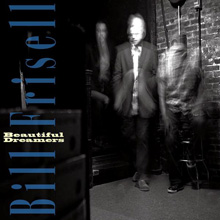 |
Another artist that makes the folks in marketing break into a cold sweat is guitarist Bill Frisell. You'd most likely find him in the jazz bins if we still had record stores. A one-time Berklee student who studied extensively with Jim Hall, Frisell can, in fact, swing with the heavyweights if and when that's what the music calls for. But he's just as likely to cover Aaron Copland or John Lennon, or take Blackberry Blossum at a crawl, or treat us to some noise. Or maybe offer up an impassioned, spacious take on an old Blind Willie Johnson song called Nobody's Fault But Mine. This is a trio setting with Eyvind Kang on viola and Rudy Royston on drums. In my liner notes—if we still had liners to note upon—I'd say, "listen to these three listen to one another!"
Audio Clip: Bill Frisell from Beautiful Dreamers, 2010.
I know what you're thinking now: "That was nice, but god I'd love to hear this song played on banjo." Right? Knew it. No shame in that—we all get there eventually, which is why banjo is so often used to cleanse the musical palette. And you don't even have to choose between clawhammer mountain music or Scruggs style three-finger rolls from down in the bluegrassier valleys. Representing the former we have a sparse and beautiful rendering from Abigail Washburn's first solo CD. Then the A-list musicians that make up Blue Highway offer up a thoroughly convincing bluegrass treatment of the tune.
Audio Clip: Abigail Washburn, from Song of the Traveling Daughter, 2005
Audio Clip: Blue Highway from Sounds of Home, 2011
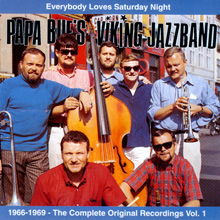 |
Now I will grant you that for all the diversity represented in the recordings we've heard so far, there is one fact about this song that is hard to interpret one's way around: it's a pretty somber subject. I wouldn't characterize any of the versions we've sampled so far as overtly "cheery". But then, we haven't been to the city that brought us the jazz funeral, now have we? That city, of course, is....Copenhagen. Okay, strictly speaking, it's New Orleans. But Arne (Papa) Bue Jensen never actually lived in New Orleans. The ambassador of Danish jazz was, however, once given the keys to the city and this cut from Papa Bues Viking Jazz Band will show us why by taking us out on an irresistably uplifting note. Those crazy Danes!
Audio Clip: Papa Bues Viking Jazz Band strutting on Nobodys Fault But Mine
All Community Guitar Resources text & material © 2006 Andrew Lawrence
